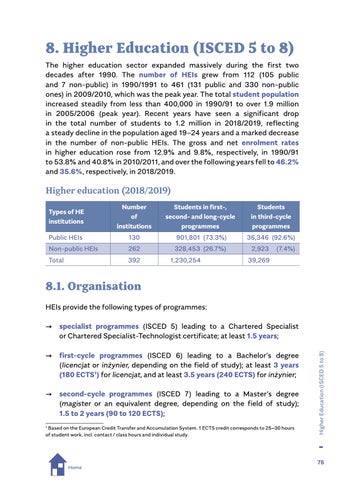8. Higher Education (ISCED 5 to 8) The higher education sector expanded massively during the first two decades after 1990. The number of HEIs grew from 112 (105 public and 7 non-public) in 1990/1991 to 461 (131 public and 330 non-public ones) in 2009/2010, which was the peak year. The total student population increased steadily from less than 400,000 in 1990/91 to over 1.9 million in 2005/2006 (peak year). Recent years have seen a significant drop in the total number of students to 1.2 million in 2018/2019, reflecting a steady decline in the population aged 19–24 years and a marked decrease in the number of non-public HEIs. The gross and net enrolment rates in higher education rose from 12.9% and 9.8%, respectively, in 1990/91 to 53.8% and 40.8% in 2010/2011, and over the following years fell to 46.2% and 35.6%, respectively, in 2018/2019.
Higher education (2018/2019) Types of HE institutions
Number of institutions
Students in first-, second- and long-cycle programmes
Students in third-cycle programmes 36,346 (92.6%)
Public HEIs
130
901,801 (73.3%)
Non-public HEIs
262
328,453 (26.7%)
Total
392
1,230,254
2,923
(7.4%)
39,269
8.1. Organisation HEIs provide the following types of programmes:
→ first-cycle programmes (ISCED 6) leading to a Bachelor’s degree (licencjat or inżynier, depending on the field of study); at least 3 years (180 ECTS1) for licencjat, and at least 3.5 years (240 ECTS) for inżynier; → second-cycle programmes (ISCED 7) leading to a Master’s degree (magister or an equivalent degree, depending on the field of study); 1.5 to 2 years (90 to 120 ECTS); Based on the European Credit Transfer and Accumulation System. 1 ECTS credit corresponds to 25–30 hours of student work, incl. contact / class hours and individual study.
1
Home
Higher Education (ISCED 5 to 8)
→ specialist programmes (ISCED 5) leading to a Chartered Specialist or Chartered Specialist-Technologist certificate; at least 1.5 years;
75

